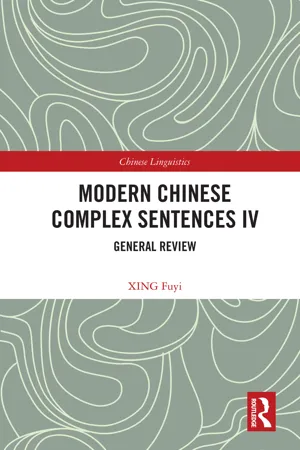
- 300 pages
- English
- ePUB (mobile friendly)
- Available on iOS & Android
About this book
This book is the final volume of a four-volume set on modern Chinese complex sentences, assessing the key attributes, related sentence structures, and semantic and pragmatic relevance of complex sentences.
Complex sentences in modern Chinese are unique in formation and meaning. Following on from analysis on coordinate, causal and adversative types of complex sentences, the ten chapters in this volume review the characteristics of complex sentences as a whole. The author discusses the constituents, related structures, semantic and pragmatic aspects of complex sentences, covering topics such as the constraints and counter-constraints between sentence forms and semantic relationships, six type-crossover markers, distinctions between simple sentences and complex sentences, clauses formed by a noun/nominal phrase followed by le, the sh?-structure, subject ellipsis or tacit understanding of clauses, as well as double-subject sentences, alternative question groups and their relationships with complex sentences.
The book will be a useful reference for scholars and learners interested in Chinese grammar and language information processing.
Frequently asked questions
- Essential is ideal for learners and professionals who enjoy exploring a wide range of subjects. Access the Essential Library with 800,000+ trusted titles and best-sellers across business, personal growth, and the humanities. Includes unlimited reading time and Standard Read Aloud voice.
- Complete: Perfect for advanced learners and researchers needing full, unrestricted access. Unlock 1.4M+ books across hundreds of subjects, including academic and specialized titles. The Complete Plan also includes advanced features like Premium Read Aloud and Research Assistant.
Please note we cannot support devices running on iOS 13 and Android 7 or earlier. Learn more about using the app.
Information
Table of contents
- Cover
- Half Title
- Series
- Title
- Copyright
- Contents
- List of diagrams
- List of tables
- 1 Counter-constraints of complex sentence form on semantic relationships
- 2 Sentences containing type-crossover markers
- 3 Distinctions and confusion between simple sentences and complex sentences
- 4 “Attribute + noun” structure acting as a clause
- 5 “NP le” acting as a clause
- 6 Double-subject sentences related to complex sentences
- 7 Subject ellipsis and tacit subject in posterior clause
- 8 shǐ-sentences with a tacit subject
- 9 Alternative question groups: beyond the scope of complex sentences (case study 1)
- 10 Alternative question group introduced by a co-referential special question: beyond the scope of complex sentences (case study 2)
- Index